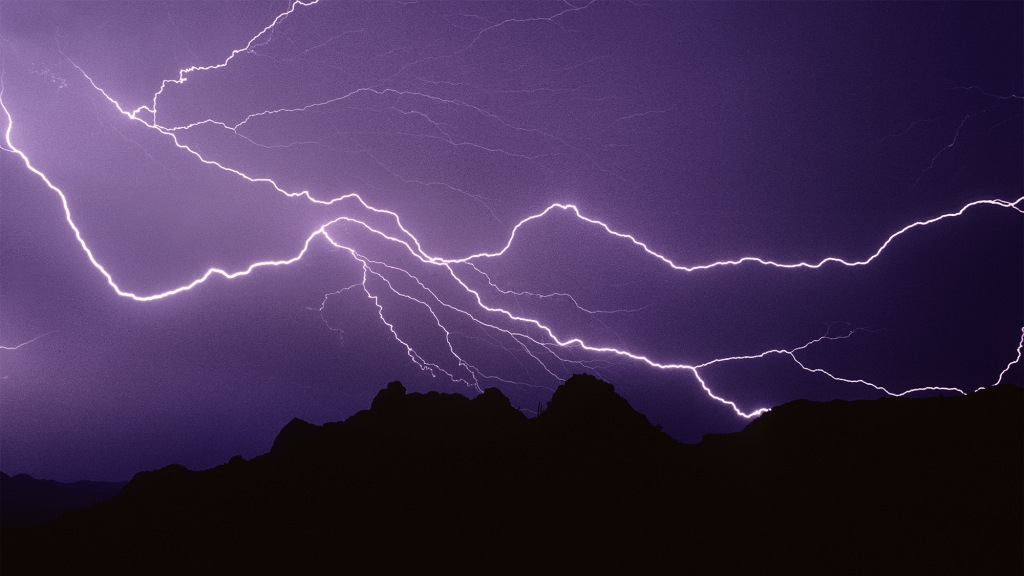There’s regular lightning and then there’s megaflash lightning. In October 2017, a single flash of lightning during a thunderstorm streaked across the Great Plains for 515 miles. The flash traveled from eastern Texas all the way to Kansas City—and now into the record books. The World Meteorological Organization (WMO) certified that this megaflash is now the longest single lightning flash in the United States. The massive lightning bolt is detailed in a study published July 31 in the Bulletin of the American Meteorological Society.
“We call it megaflash lightning and we’re just now figuring out the mechanics of how and why it occurs,” study co-author and Arizona State University climatologist Randy Cerveny said in a statement.
What is megaflash lightning?
The majority of lightning flashes reach less than 10 miles. A megaflash occurs when a lightning bolt reaches 60 miles (or 100 kilometers, to be exact). According to satellite observations, less than one percent of thunderstorms produce megaflash lightning. Megaflashes also arise from storms that are long-lived (typically those brewing in the atmosphere for 14 hours or more) and cover areas roughly the size of New Jersey. Additionally, the average megaflash shoots off five to seven ground strikes from its horizontal path across the sky. That’s a lot of lightning.
According to Cerveny, megaflashes that extend hundreds of miles are rare, but it is not unusual for common lightning bolts to strike 10 or 15 miles out from its originating storm-cloud. “The storm that produces a lightning strike doesn’t have to be over the top of you,” Cerveny said.
In the United States, lightning strikes kill 20 to 30 people (and 320 million trees) every year and injures hundreds more. Most lightning strike injuries occur before and after the thunderstorm has peaked and not at the height of the storm. “That’s why you should wait at least a half an hour after a thunderstorm passes before you go out and resume normal activities,” Cerveny said.
Measuring a megaflash
To measure the new record-holding 2017 megaflash, Cerveny and colleagues used space-based instruments. They found that the bolt’s horizontal reach surpassed the previous record holder by 38 miles. That previous record actually came from a later event: an April 2020 storm that produced a 477-mile-long streak across the southern United States. The new 2017 record-setting strike went completely unnoticed until the team reexamined satellite observations from the storm.
“It is likely that even greater extremes still exist, and that we will be able to observe them as additional high-quality lightning measurements accumulate over time,” said Cerveny.
The 2017 record smashing lightning flash occurred in the Great Plains, which is a global hotspot for Mesoscale Convective System (MCS) thunderstorms. According to the National Oceanic and Atmospheric Administration (NOAA), a Mesoscale Convective System is, “a complex of thunderstorms which becomes organized on a scale larger than the individual thunderstorms, and normally persists for several hours or more:” In other words, an enormous hours-long pack of thunderstorms. These massive storms can be both round or linear in shape and be in systems like squall lines and tropical storms. All of these atmospheric dynamics allow for these megaflashes to occur.
Recent technology continues to get better at identifying these megaflash-producing storms. Instead of the ground-based networks of antennas of the past, meteorologies now have detectors on satellites in orbit around the Earth. First launched in 2017 (the same year as the new record setter), these satellites make it possible to continuously detect lightning and accurately measure strikes across entire continents.
“Our weather satellites carry very exacting lightning detection equipment that we can use to document to the millisecond when a lightning flash starts and how far it travels,” Cerveny said.
NOAA’s GOES-16 satellite detects around one million lightning flashes per day from its perch high above the Earth. It is the first of four NOAA satellites that’s equipped with geostationary lightning mappers and is joined by similar satellites launched by Europe and China.
“Adding continuous measurements from geostationary orbit was a major advance,” added Michael Peterson, the study’s first author and a meteorologist at Georgia Tech who specializes in lightning. “We are now at a point where most of the global megaflash hotspots are covered by a geostationary satellite, and data processing techniques have improved to properly represent flashes in the vast quantity of observational data at all scales.”
[ Related: Actually, it’s not safe to crouch during a lightning storm. ]
Lightning extremes and safety
There are several other lighting extremes that the WMO has accepted for publication.
June 18, 2020 saw the greatest duration for a single lighting flash—17.102 seconds (give or take a few thousandths of a second). That flash occurred during a thunderstorm over Uruguay and northern Argentina.
In 1975, 21 people were killed by a single flash of lightning in Zimbabwe. The greatest fatalities from an indirect strike occurred in 1994 in Dronka, Egypt. After lightning struck a set of oil tanks, burning oil flooded the town and killed 469 people.
To stay safe during any thunderstorm, go indoors when lightning is detected within six miles of your location.
“The only lightning-safe locations are substantial buildings that have wiring and plumbing; not structures such as at a beach or bus stop,” added lightning specialist and WMO committee member Walt Lyons. “The second reliably safe location is inside a fully enclosed metal-topped vehicle; not dune buggies or motorcycles.” The National Weather Service has more advice on staying safe during storm season on their website.
And if you think you saw a megaflash? Be sure to report it to the National Weather Service or a local meteorologist so they can analyze the data. It could just break this new record.
The post A record-breaking lightning bolt just ‘shocked’ meteorologists appeared first on Popular Science.

